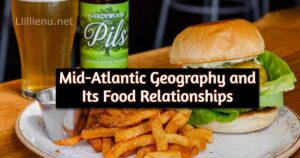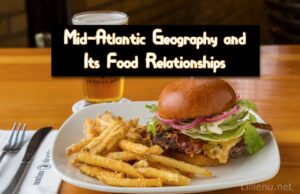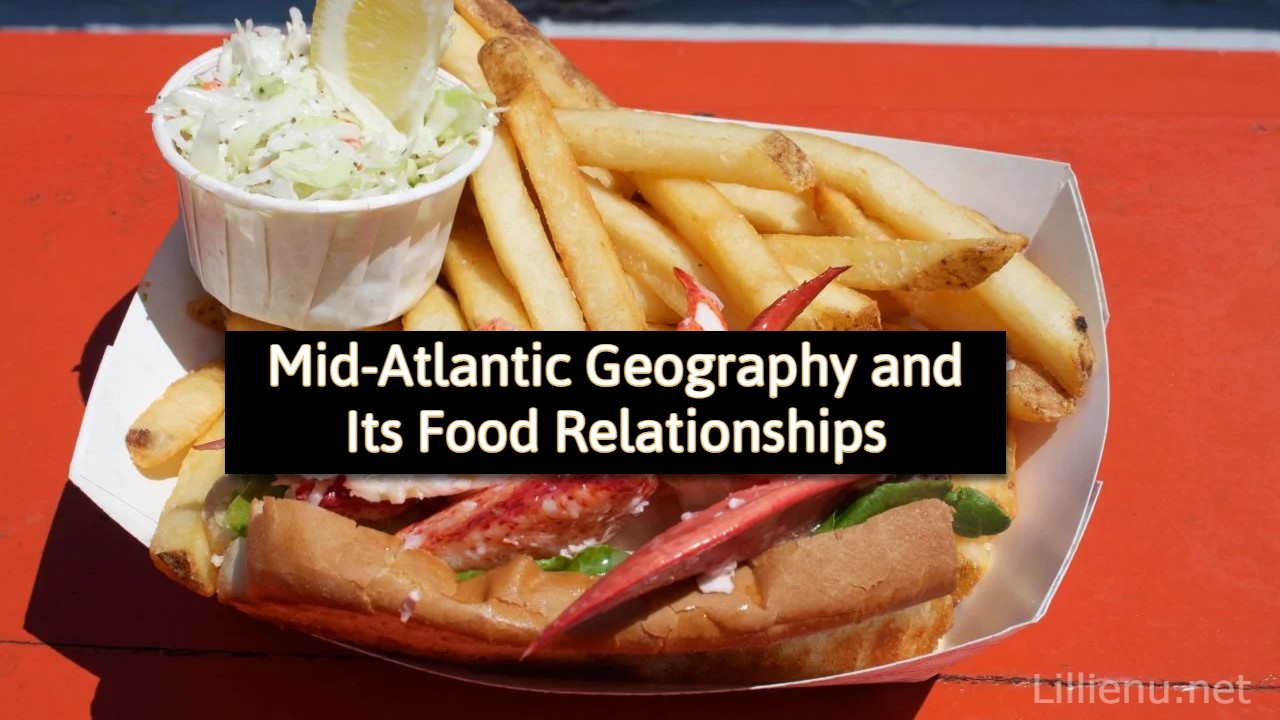It is pretty evident that Mid-Atlantic Geography and Its Food Relationships were at the core while building a kind of geographical attribute in that specific food culture within that region as this part of the state possesses mid-atlantic geography, and many climates and fertile soil near various water bodies along with its geographical fluctuation resulted in those kinds of foods together with the incomprehensible affinity that those are designed to display around this place in their own diet.
This article discusses regional geography and a food culture of richness, showing how natural factors affect local food culture and practice.
What is the Mid-Atlantic Region?
The Mid-Atlantic region comprises several states in the United States. These include New York, New Jersey, Pennsylvania, Delaware, Maryland, and Virginia.
Geographically, this area is quite vast and diversified to cover big cities and farming regions. This region, between the Appalachian Mountains to the west and the Atlantic Ocean to the east coast, allows diversified ecologies so that many varieties of agricultural production and food farming are allowed.
Intersecting of coastal and river districts as well as land districts determines what to consume in such a district.
Climate and Its Impact on Foods Prepared
The climate has dramatically changed Mid-Atlantic Geography and Its Food Relationships interactions. This is a temperate place with clear-cut seasons.
As such, at any point in the year, one can expect to come across a collection of crops that could be planted within that specific timeframe.
The long growing periods may support everything between fruits, vegetables, through to grains, legumes, any crop. Some of the farmers will plant during summer crops which can include peaches, strawberries, corn, tomatoes, among many others.
Then, at other times of the year, say fall, winter or spring, the cooler air improves the development of root crops: carrots, potatoes and winter squash.
This manner of changing climate creates the possibility for the regional seasonal foods to be produced.
Soil Quality and Farming in Mid-Atlantic
The fertile soils of Mid-Atlantic are a part of the link between Mid-Atlantic Geography and Its Food Relationships Connections.
Other arable regions include the Chesapeake Bay watersheds, the Susquehanna River Basin, and the Delaware River Basin.
Good quality soil provides an excellent opportunity for growing high-quality staple crops including wheat, soybeans, corn, and barley.
Huge fertile regions made this region the ideal region for farming by family-scale operations and larger firms that aid the region produce most of its food.
Huge farms in states like Pennsylvania and Virginia add significantly to the count of food products available.
Be it milk and meat or grains and vegetables, the Mid-Atlantic Geography and Its Food Relationships has an agricultural history long before the existence of the present food culture feeding directly into that area.
Coastal geography and abundant seafood

The Mid-Atlantic Geography and Its Food Relationships can be defined in terms of the proximity of land to the Atlantic Ocean. Coastal geography has had a great influence on the food in that area.
Fresh seafood defines the diet of the people in the Mid-Atlantic region as crabs, oysters, clams, and fish are still the most common food item in most dishes found locally.
Maryland probably boasts of having blue crabs best known because that is always the favorite one usually going into crab cakes, soups, or even crab boils.
Another industry of the region is fishing. The practice assists in developing an active market for fish such as flounder, cod, and striped bass-most of which the residents consume in restaurant menus and in household kitchens.
Seafood delicacies would never be complete with oysters, and also they throng well in the Mid-Atlantic Geography and Its Food Relationships, as one of the largest populations in the world lies within Chesapeake Bay.
Thus, oyster farming is therefore one of the segments of the economy: it does not only support a healthy environment but it is fresh supply for human consumption as well.
FreshWater Fishery and Inspired River Foods
Other rivers of the Mid-Atlantic Geography and Its Food Relationships Atlantic Ocean contribute the same to it, comprise local food culture.
Fresh water from the Delaware and Potomac rivers also from the Susquehanna river still proves to be quite an integral constituent of the local food chain, as most famously caught varieties, such as trout and bass and many catfish, find its way to neighboring kitchens.
Being such a good stream for sport and recreation, it is very easy to form associations with the availability of source local foods.
There are just so many more traditional foods prepared using the fresh water catches, such as grilled trout over an open flame or baked bass with fresh herbs and vegetables.
Rivers and streams play an important role in the ecology of the Mid-Atlantic Geography and Its Food Relationships and in the food culture that has emerged.
Urban and Rural Food Dynamics
Some of the examples are megacities, New York City and Washington D.C; huge rural areas where large farms lie within the Mid-Atlantic states in the US. Also, there is a geographical change that will alter the Mid-Atlantic Geography and Its Food Relationships pattern and behavior around the region.
Urban centers are multidimensional cities with diversities in culture that imbues a fusion of international cuisines along the world’s ingredients, innovation, and trend-setting centers with food where the chefs experiment along with new techniques of cooking globally and influences brought by locally sourcing Mid-Atlantic.
The root bases, instead, lie deeper in the two rural areas in Pennsylvania and Virginia. There on those farms the ideology of rules of farm to table is believed, and at the markets where fresh produce is sold on the spot along with its meats, dairy, and handmade goods.
So, the food prepared with seasonal ingredients was traditional recipes transmitted through generations to their local community, like that of Pennsylvania Dutch sausage and Virginia ham.
Because of modern trends and long-standing traditions, it can be claimed that a food identity is uniquely the Mid-Atlantic region as a result of the origin of urban and rural impressions.
Impact of Native Food Traditions
The Mid-Atlantic region had been occupied centuries before the emergence of the first Europeans. Not many Native American tribes inhabited this region, which were known by the names of Lenape, Powhatan, and Susquehannock.
The early settlers of the region contributed to the food culture of this region. They farmed staple crops, which included corn, beans, and squash-all known together as the “Three Sisters.” Such crops were farmed together in most cases.
Beans would climb up the stalks of corn, and squash would spread out over the ground; this way, they had a productive farming practice.
These are old favorites, appearing curiously omnipresent in the modern Mid-Atlantic cuisine. Succotash, with corn and beans, roasted squash are all typical regional fare testaments to the broad-based impact of Native American farming and food production.
Seasonal Foods and Celebrations in Mid-Atlantic

Seasonal foods and food festivals go with Mid-Atlantic Geography and Its Food Relationships well. With dramatic differences in what swings one of those main seasons, really impacts local food traditions that much about what the nature of food will be.
It heralds with fresh asparagus and strawberries coming to be present, because apples and pumpkins come to symbolize the time in autumn when harder root vegetables tend to predominate.
There are state local fairs and festivals wherein seasonal foods play a key feature. For example, the Maryland Seafood Festival often falls within Chesapeake Bay seafood celebration time when crabs and oysters, among others, are being celebrated.
Pennsylvania Dutch Folk Festival celebrates the pumpkin, apple, and fresh herbs in a preparation tradition.
Regional food celebrations will thus popularize regional food. This will make people be proud of where their food originated from, something within their own community.
Regional Specialties represent a country and its culture
Each region in the Mid-Atlantic has also developed its own regional specialties based on geography as well as cultural influence.
Pennsylvania favorites include savory pork-based loaves called scrapple and molasses-based desserts made famous by the shoofly pie.
In Maryland, of course, stand crab cakes, oysters as local favorites that can be added to seafood, while New Jersey loves salt-water fish like the flounder during seafood-rich dinners.
Direct influences to regional specialties could be directly ascribed to geography of the region, its accessibility to water bodies, fertile soils, and varying landscapes.
Foods in the Mid-Atlantic often seem to design the natural resources found within: grown locally and prepared by land and water it surrounds.
The more fluid the Mid-Atlantic Geography and Its Food Relationship, the bigger the sense of crisis to look for a solution.
Farmers continue farming and move their problems further towards full environmental responsibility in the context that agriculture needs to move on in the Mid-Atlantic region.
It even works in preservation within the soil itself, from crop rotation through responsible fishing preservation of populations.
Further, it leads to movements around promoting local food for hopes not to waste a lesser carbon footprint.
Region-to-localism and sustainability invitations have paved the way for changing in food productions, consumptions, and celebrations Mid-Atlantic has hosted to ensure that some of these hard-earned goodies will be ready for future harvests within that glorious geography coupled with a cuisine so diverse yet rich as defined for an area.
Conclusion
Mid-Atlantic geography and its food are delicately intertwined. This created a regional food culture throughout the Mid-Atlantic region over diversified landscapes and climatic, soils, and even access to water.
From ocean’s wealth to the wealth of farms, this would ensure food in the Mid-Atlantic shows what normally went on generically.
This way, association between food and geography will have become intrinsic since their change of environment as well as cultures have been done within the Midwest.
